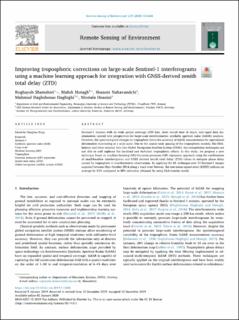| dc.contributor.author | Shamshiri, Roghayeh | |
| dc.contributor.author | Motagh, Mahdi | |
| dc.contributor.author | Nahavandchi, Hossein | |
| dc.contributor.author | Haghshenas, Mahmud | |
| dc.contributor.author | Hoseini, Mostafa | |
| dc.date.accessioned | 2021-06-03T08:44:37Z | |
| dc.date.available | 2021-06-03T08:44:37Z | |
| dc.date.created | 2020-02-08T15:54:51Z | |
| dc.date.issued | 2020 | |
| dc.identifier.citation | Remote Sensing of Environment. 2020, 239, . | en_US |
| dc.identifier.issn | 0034-4257 | |
| dc.identifier.uri | https://hdl.handle.net/11250/2757500 | |
| dc.description.abstract | Sentinel-1 mission with its wide spatial coverage (250 km), short revisit time (6 days), and rapid data dissemination opened new perspectives for large-scale interferometric synthetic aperture radar (InSAR) analysis. However, the spatiotemporal changes in troposphere limits the accuracy of InSAR measurements for operational deformation monitoring at a wide scale. Due to the coarse node spacing of the tropospheric models, like ERA-Interim and other external data like Global Navigation Satellite System (GNSS), the interpolation techniques are not able to well replicate the localized and turbulent tropospheric effects. In this study, we propose a new technique based on machine learning (ML) Gaussian processes (GP) regression approach using the combination of small-baseline interferograms and GNSS derived zenith total delay (ZTD) values to mitigate phase delay caused by troposphere in interferometric observations. By applying the ML technique over 12 Sentinel-1 images acquired between May–October 2016 along a track over Norway, the root mean square error (RMSE) reduces on average by 83% compared to 50% reduction obtained by using ERA-Interim model. | en_US |
| dc.language.iso | eng | en_US |
| dc.publisher | Elsevier Science | en_US |
| dc.relation.uri | https://www.sciencedirect.com/science/article/pii/S0034425719306285 | |
| dc.rights | Navngivelse 4.0 Internasjonal | * |
| dc.rights.uri | http://creativecommons.org/licenses/by/4.0/deed.no | * |
| dc.title | Improving tropospheric corrections on large-scale Sentinel-1 interferogramsusing a machine learning approach for integration with GNSS-derived zenithtotal delay (ZTD) | en_US |
| dc.type | Peer reviewed | en_US |
| dc.type | Journal article | en_US |
| dc.description.version | publishedVersion | en_US |
| dc.source.pagenumber | 14 | en_US |
| dc.source.volume | 239 | en_US |
| dc.source.journal | Remote Sensing of Environment | en_US |
| dc.identifier.doi | https://doi.org/10.1016/j.rse.2019.111608 | |
| dc.identifier.cristin | 1792189 | |
| dc.description.localcode | This is an open access article distributed under the terms of the Creative Commons CC-BY license, which permits unrestricted use, distribution, and reproduction in any medium, provided the original work is properly cited. | en_US |
| dc.source.articlenumber | 111608 | en_US |
| cristin.ispublished | true | |
| cristin.fulltext | original | |
| cristin.qualitycode | 2 | |

